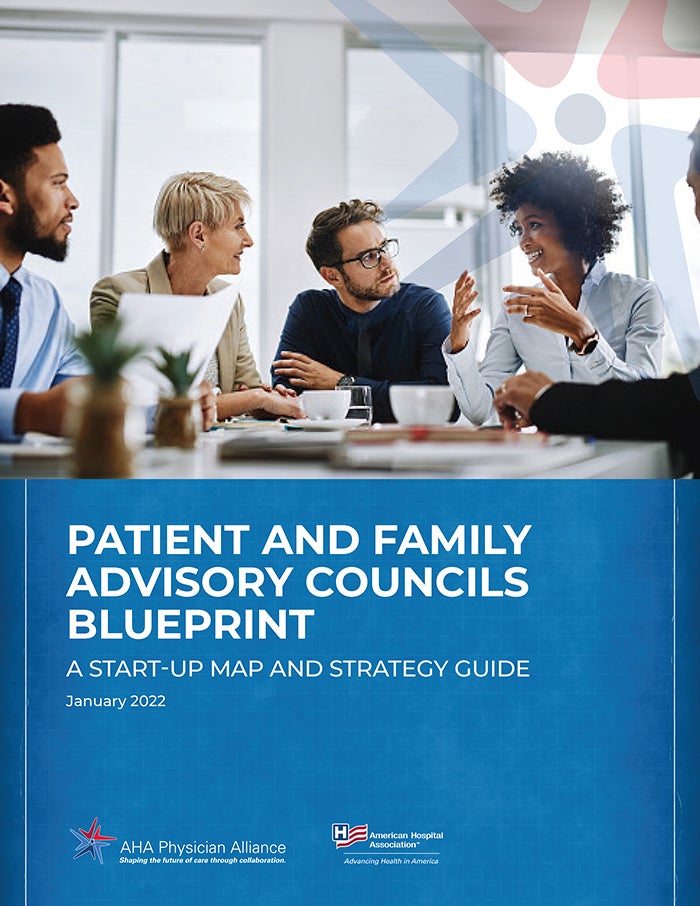
Board Responsibilities
Improving the Patient and Family Experience
How Boards Can Make a Difference
By Ann Scott Blouin and Nicole Matson
The COVID-19 pandemic was challenging for many patients and families as they interacted with hospitals and health systems. Families were no longer able to attend appointments or come into the hospital with their loved ones, limiting social and emotional support and placing additional communication barriers between patients’ families and providers. In the absence of family support, providers were shining stars that frequently went above and beyond to fill the need. These encouraging and often heroic stories positively affected patient and families but also added to the emotional toll on providers.
This physical distance combined with changing COVID-19 guidance, fatigued staff and the inability for many to access care when needed have contributed to a sense of isolation for patients and families.
The Importance of Patient and Family Engagement
Patient and family experiences are influenced by interactions across the health care system; they typically are the result of complex combinations of individuals’ wants and needs. While not an exact measurement of patient and family engagement, most hospitals and health systems do measure patient satisfaction. The most common approach is to engage a company such as Press-Ganey to survey patients after their discharge or transfer from an acute care setting.
The Centers for Medicare & Medicaid Services uses consumer perceptions in the Hospital Consumer Assessment of Healthcare Providers and Systems scores, which are publicly reported. HCAHPS scores contribute to the “hospital star rating” and are weighted as part of the federal value-based purchasing/reimbursement program.
While patient satisfaction surveys use a variety of specific measurements, hospital and health system boards should consider the basics of what patients and families really need and want from their health care experience. Generally, patients expect:
- Timely access to a diagnosis and treatment when needed
- Information and guidance about their disease or condition
- Kindness, respect and civility from the health care team
- Personalized, individualized care
- Curative treatments when possible and/or palliative care when a cure is not possible
- Avoidance of errors when receiving care
Sharing information about patient and family expectations, along with formal measurements of patient satisfaction, are leading practices for today’s effective board discussions.
Building Stronger Bonds with Patients and Families
Hospitals and health systems play a critical role in helping patients navigate a health care system that was already complex before COVID-19. Allocating resources directly toward patient and family engagement and creating a Patient and Family Advisory Council are opportunities to better understand patient needs and strengthen connections among patients, families, providers and the health care system as a whole.
Patient and family advisory councils. Members of PFACs are often a combination of current and former patients, family members and health care professionals. A PFAC gives hospitals and health systems an opportunity to receive real, consumer-focused perspectives on current and future services and programs as well as research projects.
PFACs were important before COVID-19, and those already in place undoubtedly served a critical role as new challenges arose over the course of the pandemic. For organizations that have not yet established a PFAC, now is the time. According to the American Hospital Association’s “Patient and Family Advisory Councils Blueprint,” the case for every hospital implementing a PFAC is clear:
- In an era of distancing and reduced visitation, PFACs can serve as an even stronger connection and lifeline to the voice of patients.
- COVID-19 has illuminated social, economic and health inequities in our society, so the connection to patients will be critical as hospitals and health systems continue to address health equity and structural racism.
- Without including the patient’s perspective in these critical areas, organizations risk implementing solutions that will not address the problem.
Chief patient experience officer or director of patient engagement.Some hospitals and health systems appoint a chief patient experience officer or director of patient engagement. This leader helps identify and listen to patients’ voices and opinions, using best practices from the patient perspective. This includes asking patients about their perspectives and genuinely caring about the response; valuing patient feedback and making changes when necessary; including family and loved ones in care conversations; coordinating care across multiple providers and settings; and taking ownership when a problem occurs.
Leaders that set the tone for a patient-centered culture recognize that patient and family satisfaction is about more than just excellent clinical care. Service excellence is important too; while areas like quality of food and easy access to parking may seem minor to care providers, these are factors that influence patient and family satisfaction.
The Impact of Improving Patient Experiences
Board members should consider improving patients’ experiences as a part of their fiduciary responsibility to “do our best” for those the hospital or health system serves. Beyond this clear goal of meeting community needs consistent with the hospital’s mission, a focus on patient and family engagement is an opportunity to improve how health care is delivered, strengthening both community health and the health of the hospital.
Redesigning the culture to improve quality and safety. According to the Institute for Patient– and Family-Centered Care, effective partnerships among patients, families and providers help redesign health care and improve safety in quality, leading to better outcomes and enhanced efficiency. In addition, providers experience a “more gratifying, creative and inspiring way to practice.”
The IPFCC also reports that involving patients and families as partners in care brings important perspectives about the experience of care, inspires and energizes staff, and provides timely feedback and ideas. In addition, this involvement lessens the burden on staff to fix problems, recognizing that staff doesn’t need to have all the answers.
Financial and competitive advantages. When patients’ care experiences exceed their expectations, those patients score the hospital higher on patient satisfaction and HCAHPS surveys. This directly impacts reimbursement. In addition, happy patients typically tell their friends and neighbors about their experience. While a recommendation leads to positive word-of-mouth referrals, a negative experience can often be compounded when complaints are shared through online reviews or on social media. The reputation of the hospital, clinic or individual physician can be seriously impacted, whether the comments are factual or not.
A strategic focus on patient and family engagement provides hospitals and health systems the opportunity to shift the narrative, resulting in positive patient experiences that correlate with improved care, financial benefits, and strengthened employee morale.
Ann Scott Blouin (ann@psq-advisory.com) is the president and founder of PSQ Advisory and a governWell advisor. Nicole Matson (nicole@governWell.net) is a governWell advisor and frequent contributor of articles on governance excellence.
Please note that the views of authors do not always reflect the views of AHA.

